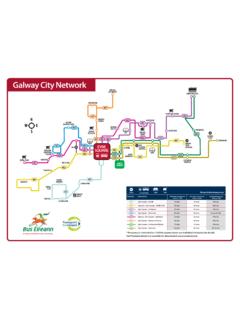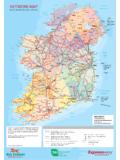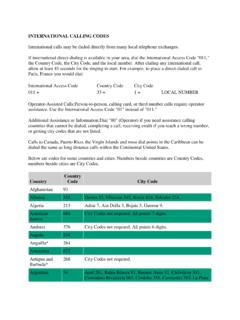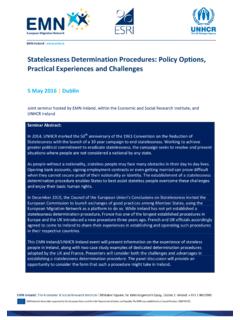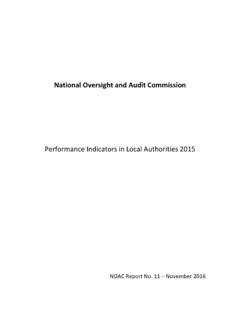Transcription of Variation No.1 Galway County Development Plan …
1 Variation Galway County Development plan 2015 -2021 Adopted: 24th April 20171 Chapter 2 - Spatial Strategy, Core & Settlement Strategy Background In its simplest terms the County Development plan s Spatial Strategy is the broad spatial distribution of people and activities, which sets the framework for the sustainable Development of Galway into the future. The Spatial Strategy is determined by examining a range of potential Development options for the County , arriving at the most appropriate outcome which will assist in delivering the Strategic Aims, as outlined in Chapter 1. Spatial Strategy In setting the framework for the sustainable Development of the County into the future, the Spatial Strategy must take account of the regional population targets set out in the Regional Planning Guidelines and determine how best to allocate this population throughout the County , over the lifetime of the plan .
2 In this regard, a number of Development options were examined so as to ascertain which option would deliver most effectively on the vision for County Galway and the Strategic Aims of the plan . Development Options A number of potential Development options are listed hereunder, which were framed having regard to a range of considerations including the size of the settlements within the County , p opulation and growth trends, regional population allocations, environmental sensitivities and the availability of services. The options are elaborated on and appropriately assessed as part of the Environmental Report of the SEA of the plan . They include a) concentrating growth in urban areas and settlements, b) focussing growth predominantly into the Hub town of Tuam, c) promoting dispersed Development throughout the County and finally d) developing the Hub town of Tuam, supporting the Gateway and key towns while encouraging the Development of other settlement centres and appropriate Development in the rural areas.
3 Preferred Development Options The County s Spatial Strategy builds on the principles established in the previous Galway County Development plan 2009- 2015 , and the frameworks provided by the National Spatial Strategy and the Regional Planning Guidelines for the West Region 2010-2022. The preferred option is primarily a structured approach to the future Development of the County , building strong urban centres, facilitating job creation and regeneration, supporting the rural economy and carefully managing the County s environmental, heritage and natural assets, while avoiding exacerbation of flood risk. The preferred Development option supports the nearby Gateway of Galway City and recognises the associated Galway Metropolitan Area, as referenced in the Regional Planning Guidelines, which includes the City area and a number of adjoining Electoral Divisions in the County which are inextricably linked to and function as part of the Gateway.
4 This option focuses on fostering critical mass in the Hub town of Tuam to complement the Gateway and promote the Development of the key towns and smaller villages along strategic Development corridors, which it is anticipated will energise the surrounding rural areas within the County . While the strategic Development corridors focus on the main established, and planned, transportation routes within the County including road and rail, simultaneously a greater emphasis shall be placed on the integration of land use and transportation generally, reducing travel distance and realising modal shift to more sustainable transportation options. This approach continues with the concept of a Strategic Economic Corridor to the east of Galway City, between Oranmore and Attymon, an area which has easy access and a high concentration of established and valuable infrastructure.
5 This area has the potential to attract significant levels of investment and stimulate economic Development and employment creation, performing a number of economic functions to support both the City, County and broader region. However, in addition to progressing the concept of the economic corridor, sustaining the buoyancy of the existing economic centres throughout the County , while 2 augmenting the tourism base and supporting sustainable rural-resourced enterprise, is critical to ensuring a balanced approach to the further Development of the County . The preferred Development option also proposes to pursue the main elements of the Galway Transportation and Planning Study (GTPS), as adopted by both Galway City and County in 2003.
6 The GTPS study area included Galway City and its hinterland, which is an area within an approximate 30km radius of the City. The recommendations of the study included both settlement and transportation options. It proposed consolidating Development within Galway City and County within a planned corridor for expansion to the east, generally known as the Ardaun and Garraun area. It also focussed on developing the main County towns within Galway s catchment, linking to Galway City via a County -based, fixed route, radial network. It also proposed to continue with the careful management of the Galway Transportation and Planning Study (GTPS) area. This is the area of the County which experienced a rapid pace of growth during the prosperous years of the Celtic Tiger, resulting in high levels of single house Development and increasing trends of dependency on the private car.
7 The Galway Transportation Strategy (GTS), which was prepared by Galway City Council and Galway County Council in partnership with the National Transport Authority (NTA) in 2016 supports the preferred Development option. The study area for the Galway Transport Strategy comprises Galway County Council administrative area incorporating the settlements of Bearna, Maigh Cuillin, Baile Chlair, Oranmore and the Galway City administrative area. The overall objective of this strategy is to address and alleviate the transportation issues within the study area. The measures that are identified within the GTS include public transport initiatives, bus network provision, rail, park and ride facilities, cycle networks and the provision of the N6 Galway City Ring Road (GCRR) which is included as a Priority Transport Infrastructure Objectives listed in Table , Chapter 5 of this plan .
8 Finally, in broader terms, the preferred Development option seeks to provide for an enhanced quality of life for all citizens in County Galway , based on high quality sustainable residential communities, developed in tandem with social infrastructure and the provision of a pleasant working and recreational environment for all. 4 Development Strategy Objectives Development Strategy Objectives Objective DS 1 Development Strategy It is the overarching objective of Galway County Council to support and facilitate the sustainable Development of County Galway in line with the preferred Development strategy option: Option 4 To Develop the Hub Town of Tuam, supporting the Gateway and Key Towns while Encouraging the Development of Other Settlement Centres and Appropriate Development in Rural Areas, which will allow County Galway to develop in a manner that maintains and enhances the quality of life of local communities, promotes opportunities for economic Development , sustainable transport options, social integration, and protects the cultural, built, natural heritage and environment while also complying with relevant statutory requirements.
9 Objective DS 2 Galway Transportation and Planning Study Area (GTPS) a) Continue to recognise the defined Galway Transport and Planning Study Area, the commuter zone of Galway City, which requires careful management of growth and strong policies to shape and influence this growth in a sustainable manner. b) Support a review of the Galway Transportation and Planning Study during the lifetime of the plan , in co-operation with Galway City Council. Consideration of the inclusion of a Strategic Transport Assessment shall form part of this review. Objective DS 3 Integrated Land Use and Sustainable Transportation Integrate land use planning and sustainable transportation planning, promote the consolidation of Development , encourage sustainable travel patterns by reducing the need to travel particularly by private transport, while prioritising walking, cycling and public transport.
10 Objective DS 4 Supporting and Securing Investment Galway County Council shall seek to secure investment or support investment, as appropriate, in the necessary infrastructure to pursue the Spatial, Core and Settlement Strategies as set out in this plan . Objective DS 5 Protection and Management of the Assets of the County Protect and manage the assets that contribute to the unique visual and environmental character and sense of identity of County Galway , and which underpin tourism, heritage, biodiversity and quality of life. 5 Objective DS 6 Natura 2000 Network and Habitats Directive Assessment Protect European sites that form part of the Natura 2000 network (Including Special Protection Areas and Special Areas of Conservation) in accordance with the requirements in the EU Habitats Directive (92/43/EEC), EU Birds Directive (2009/147/EC), the Planning and Development (Amendment) Act 2010, the European Communities (Birds and Natural Habitats) Regulations 2011(SI of 2011) (and any subsequent amendments or updated legislation) and having due regard to the guidance in the Appropriate Assessment Guidelines 2010 (and any updated or subsequent guidance).


